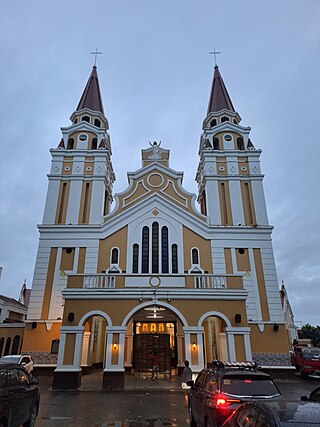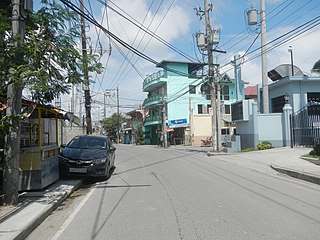
Mandaue, officially the City of Mandaue, is a 1st class highly urbanized city in the Central Visayas region of the Philippines. According to the 2020 census, it has a population of 364,116 people.

Our Lady of China, the Great Mother, also known as Our Lady of Donglü, is a Roman Catholic title of the Blessed Virgin Mary and Child Jesus associated with a purported Marian apparition in Baoding, China in 1900.

Liloan, officially the Municipality of Liloan, is a 1st class municipality in the province of Cebu, Philippines. According to the 2020 census, it has a population of 153,197 people. Liloan lies within Metro Cebu.

Banate, officially the Municipality of Banate, is a 4th class municipality in the province of Iloilo, Philippines. According to the 2020 census, it has a population of 33,376 people.

The Señor Santo Niño de Cebú is a Catholic title of the Child Jesus associated with a religious image of the Christ Child widely venerated as miraculous by Filipino Catholics. It is the oldest Christian artifact in the Philippines, originally a gift from the Conquistador Ferdinand Magellan to Rajah Humabon and his wife and chief consort, Hara Humamay on account of their Christian baptism in 1521. The image is the only canonically crowned image of Jesus Christ in the Philippines.

The Province of the Most Holy Name of Jesus of the Philippines(Spanish: Provincia Agustiniana del Santísimo Nombre de Jesús de Filipinas) was a geographical and administrative subdivision of the religious Order of St. Augustine that was formally affiliated to the Order on March 7, 1575, to originally cater the needs of the growing Augustinian presence in Philippines who were serving Filipinos in more than 300 towns in the 16th century. The Province later on expanded its presence in East Asia, Africa and the Americas in the 20th century to help build and serve more communities. It was considered to be the largest province in the whole Augustinian Order, with more than 300 affiliated Augustinian friars working in The Philippines, Spain, Tanzania, India, Venezuela, Peru, Costa Rica, El Salvador, Honduras, and China, according to a 2018 statistic from the Province.

The Order of Augustinian Recollects (OAR) is a mendicant Catholic religious order of friars and nuns. It is a reformist offshoot from the Augustinian hermit friars and follows the same Rule of St. Augustine. They have also been known as the "Discalced Augustinians".

The Cebu Metropolitan Cathedral, officially known as the Metropolitan Cathedral and Parish of St. Vitalis and of the Immaculate Conception, is the ecclesiastical seat of the Metropolitan Archdiocese of Cebu in Cebu, Philippines. Cebu was established as a diocese on August 14, 1595. It was elevated as a metropolitan archdiocese on April 28, 1934, with the dioceses of Dumaguete, Maasin, Tagbilaran, and Talibon as suffragans. Before being raised as a primatial church in Cebu, the church was one of the first churches in the Philippines dedicated to St. Vitalis and built near the fort in April 1565 by Miguel Lopez de Legazpi, Fray Andrés de Urdaneta and Fray Diego de Herrera.

The Archdiocese of Cebu is a Latin Church archdiocese of the Catholic Church in the Philippines and one of the ecclesiastical provinces of the Catholic Church in the country. It is composed of the entire civil province of Cebu. The jurisdiction, Cebu, is considered as the fount of Christianity in the Far East.

The Royal and Conciliar San Carlos Seminary is the archdiocesan seminary of the Roman Catholic Archdiocese of Manila. It was established in the year 1702, by decree of King Philip V of Spain. At present, the institution houses seminarians belonging to various dioceses in Luzon, particularly from the Metro Manila region.

The Augustinian Recollect Province of Saint Ezequiél Moreno is a division of the Order of Augustinian Recollects that has jurisdiction over the Philippines, Taiwan and Sierra Leone. It officially separated from the Province of Saint Nicholas de Tolentine on 28 November 1998. Today, the Provincialate House is located at the San Nicolas De Tolentino Parish Church on Neptune Street, Congressional Subdivision, Project 6, Quezon City.

The Diocesan Shrine and Parish of St. Augustine, commonly known as Baliwag Church, is a Roman Catholic church located in Plaza Naning at the poblacion of Baliwag, in Bulacan province, Philippines. The church is a parish church of the Diocese of Malolos, which is a suffragan of the Archdiocese of Manila.

The Archdiocesan Shrine and Parish of Saint Joseph the Patriarch, also known as Saint Joseph the Patriarch Church, is a Roman Catholic church located in the town center of San Jose, Batangas, in the Philippines. The church is known for being one of the parishes that Fr. Manuel Blanco OSA, who authored the Flora de Filipinas, administered.

Bagumbayan is one of the 38 barangays of Taguig, Metro Manila in the Philippines. It is also one of the nine original Barrio of Taguig.

Bambang is one of the 38 barangays of Taguig, Metro Manila in the Philippines. One of the 9 initial Barrio of Taguig.

The Metropolitan Cathedral of Our Lord's Transfiguration, also known as Palo Metropolitan Cathedral or simply Palo Cathedral, is a Roman Catholic church located at Palo, Leyte, in the Philippines belonging to the Vicariate of Palo under the Metropolitan Archdiocese of Palo.

Napindan is one of the 38 barangays of Taguig, Metro Manila, Philippines. One of the 18 barangay of Taguig when it became a part Metropolitan Manila on November 7, 1975.

The Archdiocesan Shrine of Santa Teresa de Avila, previously known as Santa Teresa de Avila Church, is a Roman Catholic church located in Talisay, Cebu, Philippines. Built in 1836 until 1848, architecturally, the church is in classical Graeco-Roman style, featuring the facade's two bell towers connected by a porch with two supporting columns on the foyer. On October 15, 2007, it was declared an archdiocesan shrine and pilgrims could receive plenary indulgence for a year.

Santa Ana is one of the 38 barangays of Taguig, Metro Manila, Philippines. It is one of the nine original barrios of Taguig. It is named after Saint Anne, who is the patroness of the barangay.





















